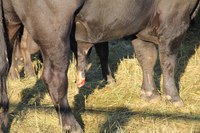Watch Bulls Before, During Breeding Season
(Click the image below to view a high-resolution image that can be downloaded)
More than 80 percent of producers in North Dakota likely will have bulls actively breeding cows in their pastures on Aug. 1.
“The importance of pre-breeding bull management often is highlighted as a means to prepare for a successful breeding season,” says Carl Dahlen, North Dakota State University Extension Service beef cattle specialist. “However, a successful breeding season is not necessarily guaranteed once healthy bulls are turned out with a group of females.”
A breeding soundness exam (BSE) should have been conducted on bulls prior to the breeding season to identify unsatisfactory bulls, which are unlikely to sire as many calves as bulls that passed a BSE.
A BSE evaluates indicators of fertility such as semen motility and morphology. It should be performed along with an internal examination and an evaluation of physical characteristics vital to breeding success.
“A BSE does not, however, give an indication of a bull’s libido, or desire to breed,” Dahlen says. “After turnout, a simple step producers can take to evaluate libido is to watch pastures and make sure bulls are actively seeking and breeding females.”
Watching bulls also can help producers spot physical deformities (deviated penis, inability to extend penis, etc.) and other issues that can prevent successful intromission and ejaculation from occurring. In these instances, a bull may be mounting cows in heat but not completing a successful breeding. Pay attention to the entire mating process to make sure erection, intromission and ejaculation all are occurring.
In addition, keeping an eye on the bulls will help producers notice injuries that occur during the breeding season and limit the bulls’ ability to breed cows successfully. Some injuries are readily identified and others may require close observation.
Major injuries that would make bulls physically unable to perform, such as broken or sprained legs, likely would be easy to spot. Lacerations that result in a penis not able to retract are easy to see as well.
Other cases are not as easy to identify. For example, swelling just ahead of the scrotum may indicate a “broken penis” or a hematoma, and swollen or misshapen testicles may indicate testicular injuries.
“Injuries may cause physical pain and a low libido, or a bull may be willing to breed but is no longer capable,” Dahlen says. “In any case, part of the healing process can create scar tissue, and this scar tissue may interfere with future reproduction.”
He suggests producers observe bulls interacting with females and females interacting with each other early in the breeding season because those interactions can give a good indication of the relative proportion of females that are cyclic.
To get bred and become pregnant in natural-service breeding systems, females must be cyclic and stand to be bred. If producers expect that 60 to 65 percent of females will calve within the first 21 days of the calving season in a herd of 100 cows, then a minimum of about three cows must be bred per day during the first 21 days of the breeding season.
“The number is actually slightly higher because not all matings result in a pregnancy,” Dahlen says. “If all cows are cyclic, we expect to see almost 5 percent in estrus on a daily basis.”
Fewer and fewer females will be in estrus on a daily basis from the middle to the end of the breeding season. So if 65 percent of the cows became pregnant in the first 21 days, then only 35 percent of the herd remains to be bred. This means less than two cows would be in estrus per day in a herd of 100 cows from day 22 to 42 of the breeding season. After day 42 of the breeding season, only one female should be in estrus every other day for the remainder of the breeding season.
“If close observation of pastures reveals that a relatively similar proportion of cows are in estrus in the middle of the breeding season, compared with early in the breeding season, then some type of intervention is critical,” Dahlen says “Check that cows are in acceptable body condition (body condition should have been increasing up to this point), and have minerals and access to sufficient high-quality feed resources.”
Once bulls have been evaluated for injuries, body condition and libido, and single-sire pasture bulls have been evaluated for the ability to mate successfully, producers should take active steps to rotate or replace bulls that are injured, have low libido or are in pastures with a high proportion of estrus cows late in the breeding season, Dahlen advises.
“Although not all problems will be immediately seen, such as the case with changes in semen quality after the yearly BSE, identifying issues before the end of the breeding season will allow time to replace bulls that need to be replaced and salvage the remainder of the breeding season,” he says. “Intervention during the middle and end of the breeding season likely will result in more late-calving cows than anticipated, but the alternative is to have a much greater proportion of nonpregnant cows than anticipated.”
NDSU Agriculture Communication - July 24, 2013
| Source: | Carl Dahlen, (701) 231-5588, carl.dahlen@ndsu.edu |
|---|---|
| Editor: | Ellen Crawford, (701) 231-5391, ellen.crawford@ndsu.edu |


